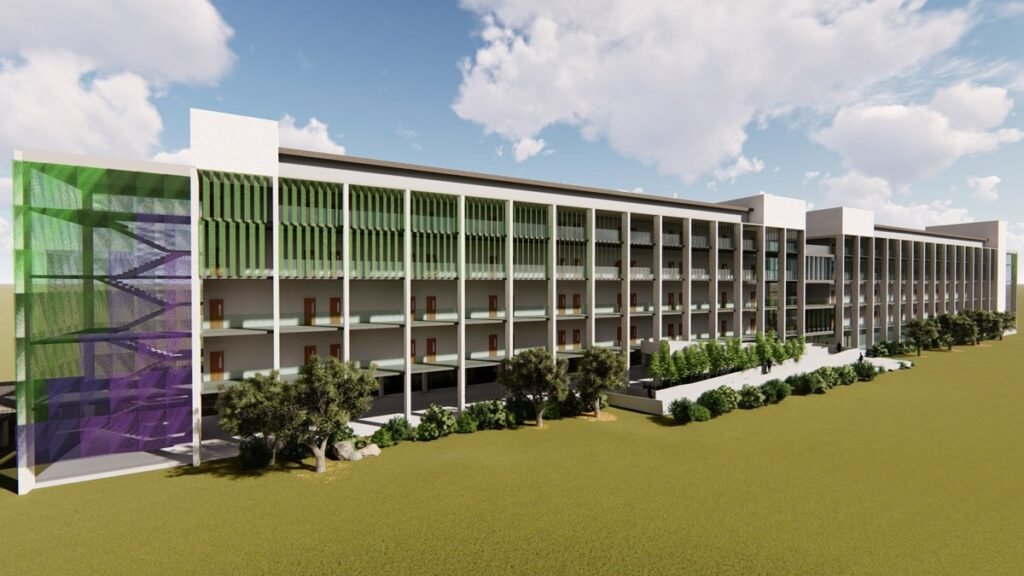- MITCH M. LIPA
P350 million state-of-the-art school building. Plans for the construction of Professional Schools building. Integration of environment and ecological education in the Agri-business campus in Granada.
Strengthening of online education. Faculty development for the acquisition of information technology-related doctoral degrees.
These are among the developments shared by Br. Joaquin “Kenneth” Martinez, president and chancellor of the University of St. La Salle, in an interview with NEGROS NOW DAILY / NEGROS WEEKLY conducted last week.
***

Can you update us on infrastructure development in the university? You have earlier mentioned about reconstruction of the new Integrated School and other buildings.
Before the pandemic, we were in the K to 12 transitions. The facilities were already being occupied by Senior High School students. We had about 2,000 students using most of the college facilities, most of which are enrolled in the STEM program, which heavily uses laboratories.
So, when we are having the master planning, we were already anticipating a deficit of classrooms. When the college programs will be in full force, there would be fewer classrooms available. That motivated us and fast-track a new building in the Integrated School to replace the old one at C.L. Montelibano Avenue.
The turnover of the new building will be in February. It will have 42 classrooms with a library and three laboratories, including an IT lab. This is one of the highlights of university accomplishments in terms of infrastructure development.
As we already know, the architecture is really built to accommodate the free flow of people. The ground floor is elevated with the exception of the library in the first half of the wing, which is already on stilt and right beside it is what we call Agora – the live, work and play environment and a performance space, all outside but with roofing.
We are also planning to renovate the old IS building at C.L. Montelibano for professional schools. The College of Law is already more than 25 years and the Medical School was started in 2002, and yet they don’t really have a building dedicated for them, so what we are doing is, once the IS transfers to the new building, we will start by next month the renovation of the old one to be used as the professional schools building. We have another campus in Granada, which is for the Agri-business program and the Eco-Park, as well as the Bahay Pag-asa.
What we are looking at next school year is to come up with the Master Plan that will fully integrate environment and ecological education in the Granada Campus. This is a perfect place to bring kids to understand the environment and to appreciate agriculture under our Agribiz program.
We have a piggery, poultry and livestock raising, and we would like to expose our students to the reality that agriculture is also a career and we need to bring them to the outdoors – which is perfectly situated in the 5-ha. Eco-Park Granada campus.

Please tell us more about the new IS building.
You know, we believe with prayers and hope that we will have some form of flexible learning arrangement. We will have face-to-face classes once the vaccine comes in, so we’re just waiting for the IATF for this possibility, because we also believe that the facility is not all classroom and building, but a living environment, too, where students can really enjoy, live and play, and learn and study in a setting conducive to them.
The entire campus is now equipped with Smart Wifi system, thus in majority of the common areas, Wifi is available.
How much did the school spend for the new IS building?
The new IS building is an almost P300 million investment, basically a loan from the Development Bank of the Philippines. With savings and donations, it costs about P350 million.
Will that mean an increase in tuition because of the new facilities?
This current year, we did increase in accordance to the inflation rate of the region. We realign majority of our miscellaneous fees and we think we would probably continue the re-adjustments depending on what is possible in the new normal. We have to understand this scenario is completely quickly changing, so it’s possible that we will propose but we’re not very sure at the moment, depending on the scenario…
If ever we increase the tuition fees, it would be based on Western Visayas inflation rate for the first two quarters of the semester. We are trying to be sensitive to the reality of economy, which has slowed down. We’re not sure until we see what’s happening to our economy and its effects.
How’s the enrollment during this academic school year?
Overall it did not suffer, as I told you the K to 12 program has involve the slow entry of college students already. So when you look at it in the previous year, we only had first year and second year students. For this year, we have first year, second year and third year college students.

So overall, we added actually around 600 to the enrollment of 2019-20 school year. However, it is a bit lower in the entry level – Grade 1, Grade 7, Grade 11 and first year college. Enrollment in the entry point reduced by 3 to 5 percent, but overall, we have 600 more students, including our Law and Medical schools.
We have a bumper crop entry of medical students, and for the Law School, classes are in full capacity. Meaning, we have historic number of medical students enrolling, partly because we have increased our performance in Law and Medical schools.
Mayroon na tayong mga topnotcher sa Bar Exam at sa Medical Licensure Exam. The performance in the bar exam and the medical licensure exam contributed to the increase of our enrollment, especially in the medical school. Nakakatuwa yan. In the College of Law, the enrollment increased by 20 percent. Sa Law kasi talagang piling pili ang students. As far as I know, talagang full classes ang sa Law School at ganon din sa Medical School.
USLS graduate Patrick Mabugat rank Number 2 in the Medical Licensure Exam last year.
What incentive did USLS give Patrick Mabugat?
Aside from cash incentives, we recognized him in the testimonial dinner for all passers and in public recognition rites. Mayroon kaming cash gift sa kanya, mayroon din kaming tulong sa kanya that his efforts are amply rewarded, kasi he has applied to the CLMMRH for residency.
He was, by the way, a scholar of the provincial government. He decided to train in the province, so ang galing ng kanyang value system. When we had a talk, I realized ang ganda ng kanyang experience.
About 30-plus medical students availed of the scholarship for medical studies offered by the provincial government. Since 2018, there has been a return service by these scholars, who joined municipal and city health offices, and the regional hospitals with the doctors for the barrio program.
The nursing program has also a bumper enrollment. Our health professional programs are in full capacity. Maybe they would have considered going to Iloilo, Cebu or Manila to take up Medicine and Nursing, but now because of the pandemic, they preferred to stay in Bacolod.
It makes a lot of sense – instead of going to Manila or other schools and universities in the region, they now express preference to study here lalo na maganda ang ating results sa Physician Licensure Exam. Our passing score was above the national passing rate.
What about the highlights in faculty development?
All our trainings are now shifted on an online delivery of education. We already enrolled in Canvas Technology like in Harvard. The best education now is the best way to carry on online education. Even our graduate school and our Project FREE Program, which is the massive upgrading of public school teachers, are now online…
We are now negotiating to send our IT teachers to PhD program and doctorate in Computer Technology in De La Salle University in Manila. So, the majority of faculty will be trained at DLSU for their doctorate degree in IT.
We want now to be a center of IT education. You know, our students are now employed in the region as the preferred graduates in Information Technology. A lot of our alumni are in Cebu, Iloilo and other parts of the country, employed as IT professionals. Thus, we are frontlining the PhD training of our faculty.
What are the academic highlights for the year?
Actually our academic programs right now are concentrating basically on, first, being expert in online technology. Once we do this, hopefully we can ramp up our programs. Right now, we are not expanding to other programs yet until we have defined our expertise in the area of online education.
When we talk about academics, ang daming formation programs and activities that have shifted online. We have successfully shifted graduation online, mental wellness online, recollection, and Eucharistic celebrations are online already.
In terms of delivery of education, especially in the college level, we have a modular program for students who have no connectivity in their respective places. Because we don’t want our students to have learning access difficulty, we want them to be in school no matter what it takes. So we are finding ways to make education accessible no matter what.
We are also ramping our continuing program for autonomous status. Our autonomous status is very important. This is a recognition from the Commission on Higher Education. We have been autonomous for the long time and we are strengthening our compliance with the requirements for autonomy and part of that is basically in research and publication. CHED has many requirements now for the graduate school to attain autonomous status. In the next few years, we will submit the requirements for the renewal of our autonomous status.
The quality of assurance is very important because, right now, under the pandemic the requirements for other programs for autonomous status have been deferred until they can be strong in online education.
We continue the Project FREE program for public school teachers, which has about 1,000 enrollees from north to south of the province. We also enrolled Diocesan scholars from across four dioceses in Negros Island. We have a memorandum of agreement with the four bishops of Dumaguete, Kabankalan, San Carlos and Bacolod. We have 25 scholars under this agreement.
At the same time, we are also strengthening our tie-up with the United Board for Christian Higher Education, which is an Asia Pacific Group of Universities and Colleges. We are very strong with that. Hopefully we are also continuing our associate membership with ASEAN University Network.
We’re one of the few in the country that is an associate member of the network. That means, assurance of quality programs in the next three years will be of ASEAN Network standards. So, we are hoping that after the effects of the pandemic, we’ll begin the program assessment and we will have international program assessors coming to the campus.
We are also strengthening our linkages with the province, the Sugar Regulatory Administration and the City of Bacolod to accredit ourselves as their research arm. We are, likewise, sending our sugar technicians through SRA to Thailand for exposure and study in one of the Thai provinces that focuses on sugar agriculture. Once the quarantine restrictions are lifted, we will continue the negotiations for this…
The best idea now is to bring the students back to school. This is the best help that the government can do to help us, kahit na sana sabihin nating nasa blended lang, hindi na full classes. We’re ready for this.This Q & A was edited for clarity and news style. – NWI




